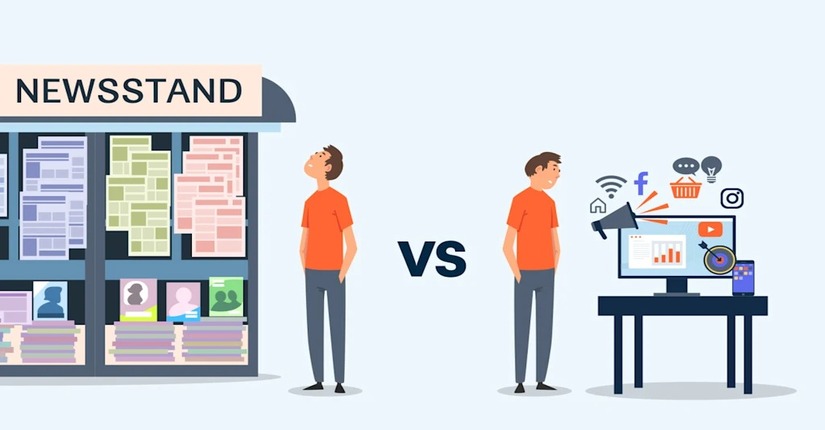Digital vs. Traditional Advertising: Choosing the Best Fit
In the fast-paced world of marketing, businesses face a crucial decision: should they invest in digital advertising or stick with traditional advertising? Both methods offer unique advantages, but the right choice depends on your business goals, target audience, and budget. Let’s explore the key differences to help you determine the best fit for your business.
Understanding Digital Advertising
Digital advertising refers to marketing strategies that utilize online platforms such as search engines, social media, email, and websites. With the rise of technology and internet usage, digital marketing has become an essential tool for businesses of all sizes.
Advantages of Digital Advertising
- Targeted Reach: Digital platforms offer advanced targeting options, allowing businesses to reach specific demographics, interests, and locations.
- Cost-Effectiveness: Small businesses with limited budgets can benefit from digital ads, as platforms like Google Ads and Facebook Ads offer flexible pricing models.
- Measurable Results: Tools like Google Analytics provide real-time data, enabling businesses to track performance and optimize campaigns.
- Interactive Formats: Digital advertising allows for engaging formats like videos, interactive polls, and gamified content, enhancing user experience.
- Global Access: With the internet, businesses can connect with audiences worldwide, breaking geographical barriers.
Popular Forms of Digital Advertising
- Social Media Ads: Platforms like Instagram and LinkedIn offer targeted ad placements.
- Search Engine Marketing (SEM): Paid campaigns appear at the top of search results.
- Email Marketing: Personalized email campaigns drive customer engagement.
- Display Ads: Banner ads on websites attract potential customers.
Understanding Traditional Advertising
Traditional advertising refers to conventional methods like TV, radio, newspapers, billboards, and direct mail. These strategies have been used for decades to build brand awareness and trust.
Advantages of Traditional Advertising
-
- Broad Audience Reach: Television and radio ads can reach millions of viewers and listeners simultaneously.
- Credibility and Trust: Established mediums like newspapers lend credibility to advertised products.
- Tangible Impact: Physical ads, such as flyers or magazines, create a lasting impression.
- Local Focus: Traditional methods are ideal for businesses targeting specific local areas.
- Fewer Distractions: Unlike digital ads, traditional formats often face less competition for attention.
Popular Forms of Traditional Advertising
- Television and Radio: Ideal for storytelling and reaching a mass audience.
- Print Media: Newspapers and magazines offer space for detailed information.
- Outdoor Advertising: Billboards, transit ads, and posters capture attention in high-traffic areas.
Digital vs. Traditional Advertising: Key Differences
- Cost: Digital advertising is often more affordable than traditional methods, making it a popular choice for startups and small businesses.
- Measurability: Digital campaigns provide detailed analytics, while traditional ads rely on indirect metrics like surveys.
- Flexibility: Digital ads can be updated instantly, whereas traditional campaigns require significant lead time for changes.
- Audience Targeting: Digital platforms excel in precision targeting, while traditional advertising offers broader reach.
- Engagement: Digital ads encourage direct interaction, such as clicks and shares, while traditional ads focus on passive consumption.
Choosing the Right Strategy for Your Business
The choice between digital advertising and traditional advertising depends on your unique business needs. Consider the following factors:
1. Target Audience
- Younger, tech-savvy audiences respond well to digital campaigns.
- Older demographics may prefer traditional media like TV and print.
2. Budget
- For businesses with limited budgets, digital platforms provide cost-effective options.
- Larger companies can invest in high-budget traditional campaigns to build widespread brand awareness.
3. Business Goals
- If your goal is to drive website traffic or generate leads, digital advertising is ideal.
- For brand building or community engagement, traditional advertising may be more effective.
4. Industry and Product Type
- Tech and e-commerce brands thrive with digital strategies.
- Local businesses, restaurants, and retail outlets benefit from traditional ads.
5. Geographic Reach
- Digital platforms allow global outreach, ideal for international businesses.
- Traditional methods are better suited for localized campaigns.
Combining Digital and Traditional Advertising
To achieve the best results, many businesses opt for a hybrid approach, leveraging both digital advertising and traditional advertising. For example:
- Use billboards to build awareness in high-traffic areas and complement them with targeted social media campaigns.
- Combine TV ads with YouTube pre-roll ads to maximize reach.
- Distribute print materials at events while driving online traffic through QR codes.
Conclusion
The debate between digital advertising and traditional advertising doesn’t have a one-size-fits-all answer. By understanding the strengths of each approach and aligning them with your business objectives, you can create a marketing strategy that delivers maximum impact. Whether you choose digital, traditional, or a mix of both, the key lies in knowing your audience and staying adaptable in an ever-changing market.


0 Comment